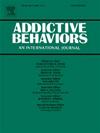Exposure to vaping and smoking prohibitions and nicotine and cannabis vaping in a California-based sample of young adults: An ecological momentary assessment study
IF 3.7
2区 医学
Q1 PSYCHOLOGY, CLINICAL
引用次数: 0
Abstract
Background
Localities have extended smoke-free policies to prohibit use of combustible and vaping products for nicotine/tobacco and cannabis (THC), but little is known about how this affects vaping behavior. We used Ecological Momentary Assessment to examine perceived exposure to smoking- and vaping-specific prohibitions and nicotine and THC vaping.
Methods
Young adults (n = 178; age 25; 55 % male; 47 % Hispanic, 21 % Asian, 21 % White) in California who endorsed past-month use of nicotine and/or THC vaping products were recruited from an existing longitudinal study. In 2023, individuals completed up to five brief surveys each day over 21 days to assess vaping behavior and momentary context (e.g., vaping/smoking prohibitions) of vaping and non-use (random prompt) events. Multilevel generalized linear mixed models assessed associations between exposure to prohibitions and likelihood of vaping nicotine or THC (vs. non-use events).
Results
Young adults showed reduced likelihood of vaping nicotine (aOR = 0.60, 95 % CI 0.42 – 0.85; p = 0.004) and THC (aOR = 0.48, 95 % CI 0.33 – 0.69; p < 0.0001) in settings where vaping and smoking were prohibited compared to settings in which vaping and smoking were allowed. Exposure to settings in which only smoking was prohibited (vaping allowed) was associated with increased likelihood of vaping nicotine (aOR = 2.13, 95 % CI 1.34 – 3.39; p = 0.002), but unrelated to vaping THC (aOR = 0.87, 95 % CI 0.53 – 1.44; p = 0.59).
Conclusions
Efforts to increase young people’s awareness of and compliance with vaping prohibitions may help reduce both nicotine and THC vaping in real-world settings.
加利福尼亚州年轻成年人样本中的吸食和吸烟禁令接触情况以及尼古丁和大麻吸食情况:生态瞬间评估研究
各地已经扩大了无烟政策,禁止使用尼古丁/烟草和大麻(THC)的可燃和电子烟产品,但人们对这对电子烟行为的影响知之甚少。我们使用生态瞬时评估来检查对吸烟和电子烟特定禁令以及尼古丁和四氢大麻酚电子烟的感知暴露。方法青壮年(n = 178;25岁;55%男性;(47%的西班牙裔,21%的亚洲人,21%的白人)在过去的一个月里使用尼古丁和/或四氢大麻酚电子烟产品,从现有的纵向研究中招募。2023年,参与者在21天内每天完成多达5项简短调查,以评估电子烟行为以及电子烟和不使用电子烟(随机提示)事件的瞬间背景(例如,电子烟/吸烟禁令)。多层广义线性混合模型评估了暴露于禁令与吸食尼古丁或四氢大麻酚的可能性之间的关系(与未使用事件相比)。结果年轻人吸尼古丁的可能性降低(aOR = 0.60, 95% CI 0.42 ~ 0.85;p = 0.004)和THC (aOR = 0.48, 95% CI 0.33 ~ 0.69;p & lt;0.0001),在禁止吸电子烟和吸烟的环境中,与允许吸电子烟和吸烟的环境相比。暴露在只禁止吸烟(允许吸电子烟)的环境中与吸尼古丁的可能性增加有关(aOR = 2.13, 95% CI 1.34 - 3.39;p = 0.002),但与吸食THC无关(aOR = 0.87, 95% CI 0.53 - 1.44;p = 0.59)。结论努力提高年轻人对电子烟禁令的认识和遵守可能有助于减少现实环境中尼古丁和四氢大麻酚的使用。
本文章由计算机程序翻译,如有差异,请以英文原文为准。
求助全文
约1分钟内获得全文
求助全文
来源期刊

Addictive behaviors
医学-药物滥用
CiteScore
8.40
自引率
4.50%
发文量
283
审稿时长
46 days
期刊介绍:
Addictive Behaviors is an international peer-reviewed journal publishing high quality human research on addictive behaviors and disorders since 1975. The journal accepts submissions of full-length papers and short communications on substance-related addictions such as the abuse of alcohol, drugs and nicotine, and behavioral addictions involving gambling and technology. We primarily publish behavioral and psychosocial research but our articles span the fields of psychology, sociology, psychiatry, epidemiology, social policy, medicine, pharmacology and neuroscience. While theoretical orientations are diverse, the emphasis of the journal is primarily empirical. That is, sound experimental design combined with valid, reliable assessment and evaluation procedures are a requisite for acceptance. However, innovative and empirically oriented case studies that might encourage new lines of inquiry are accepted as well. Studies that clearly contribute to current knowledge of etiology, prevention, social policy or treatment are given priority. Scholarly commentaries on topical issues, systematic reviews, and mini reviews are encouraged. We especially welcome multimedia papers that incorporate video or audio components to better display methodology or findings.
Studies can also be submitted to Addictive Behaviors? companion title, the open access journal Addictive Behaviors Reports, which has a particular interest in ''non-traditional'', innovative and empirically-oriented research such as negative/null data papers, replication studies, case reports on novel treatments, and cross-cultural research.
 求助内容:
求助内容: 应助结果提醒方式:
应助结果提醒方式:


